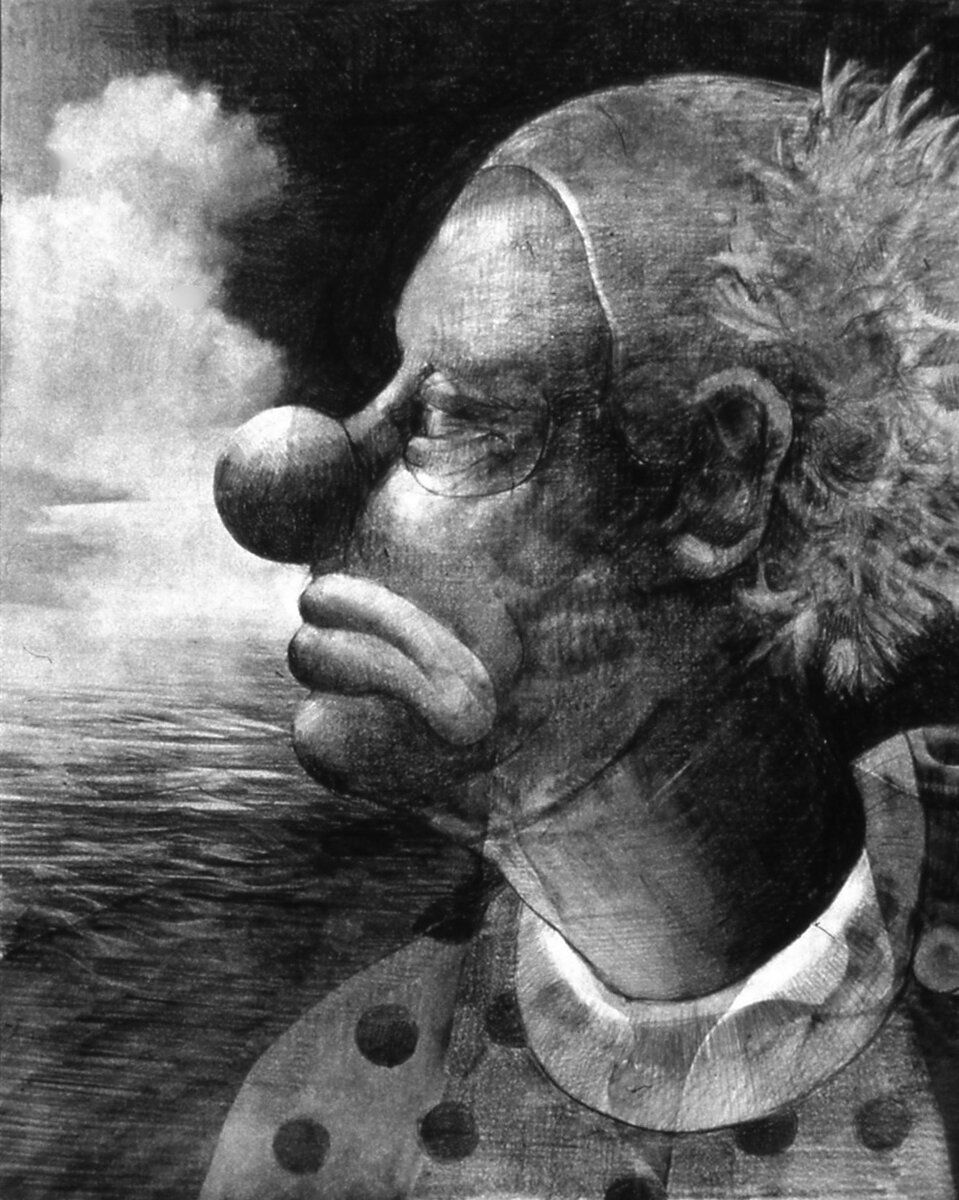In 2004 Rob Storr curated Site Santa Fe’s Biennial titled ‘Disparities and Deformations: Our Grotesques’. During the course of the Biennial I saw the picture below of Rob Storr taken by Guy Cross, the publisher of ‘The Magazine” that accompanied an interview he gave. The photograph of Storr was a full bleed made all the more beautiful as the publication was printed on newsprint. When I first saw this image, I thought how much Rob Storr reminded me of the actor Karl Malden, and though a bit idiosyncratic, I always thought that Malden had the look of a sad clown.
Back in my studio I found myself drawing on the photo to see, first if I could renovate the image of Storr into that of a clown and second if I could transform the photograph into a drawing. The fact that the image was printed on newsprint allowed me to erase ink while the soft graphite perfectly matched the gray scale of the photograph. When I finished I was surprised to see that the photographic image continued to assert itself in spite of how vigorously I had manipulated the surface.
This led me to wonder if I could completely negate the printed image. So, I took another copy of the photograph to do a variation of Rauschenberg trying to erase a DeKooning, but in this case I wanted to see if I could obliterate the photograph by using graphite and an eraser. I made 12 separate drawings over the Storr photograph that eventually became ‘Clown Calendar’*. In each of the 12 attempts, regardless of the effort I made to eradicate the image, I was unable to remove all traces of the photograph. The printed image of Storr continued to retain its power, which lingered like a ghost behind the image of the Clown.
The effort to reorient the photograph of Storr into a Clown drawing revealed what should have been evident at the beginning – that the printed process and photography itself, is too much of a hegemonic medium to be displaced by the hand or the tradition of drawing.
I started to follow Storr after I saw his first MoMA show, ‘Dislocations’, which was wonderful and at the time somewhat unique for its focus on installations. Highlights of the show included a large piece by Louise Bourgeois that I found funny in how she situated a very large phallic cylinder that had a piston moving in and out in a dramatically lit room that felt a bit theatrical leaving the viewer to wonder if it was a sexual reference or just a reminder of how big patriarchy is. The show included an amazing David Hammon installation as well Adrian Piper, Bruce Nauman, et. Al.
I had the opportunity to hear Storr talk about his exhibition, ‘Dislocations’, for a student group at NYU in the early 90’s. Storr’s passion was obvious during his talk which even flared up a bit when one of my students questioned the effectiveness of Chris Burden’s “Other Vietnam Memorial” in relation to his overall body of work. Storr’s response was sharp where he provided the context of the how the piece was a major statement against the war in Vietnam and was also a counterpoint to Maya Lin’s Vietnam Memorial. He explained how important it was to protest against US involvement in the war for artists during the late 1960’s and 70’s.
An older artist/faculty member I knew who was in the audience actually shouted “who does he think he is” after the student made the statement. Later this older artist was taken aback when I told him that the student’s mother was the curator of contemporary art at a major museum who had put together an exhibition of Burden’s work. I suggested that since the student was actually very familiar with Chris Burden that his comment came from experience and evaluation and was not simply naive. But I was struck by the generational response by the older artist to the student’s statement. For the student the war was a historical reference and in his view Burden’s “Other Vietnam Memorial” was a bit didactic and less complex than his other work. For the older artist, who had protested bitterly against the war, his outburst seem to suggest that his lived experience should carry more weight than the student’s assessment.
I apologize to anyone who suffers from coulrophobia.
Clown Calendar: May & September
graphite over photograph
2004
Collection of Crystal Bridges Museum of American Art






